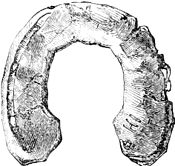groove is very near the outer circumference of the shoe, and contains four nail-holes on each side; these are oblong and small, and a portion of a nail yet remaining is not unlike our present nail. There is no toe or other clip, and the outer circumference of the shoe is thinner than the inner, in such a way that the ground surface is slightly convex, and that towards the foot, particularly at the heels, is concave. There are no calkins, and the shoe altogether is coarse and heavy. Though much worn and oxidized, it yet weighs nearly 12 ounces.
Another specimen, found in excavating for a sewer in Walworth road, London (fig. 156), in 1825, is very similar in shape and character. It was discovered at a depth of 10 feet, and from the fashion of a buckle procured with it, is assigned by Mr Syer Cuming[1] to the first half of the 17th century; though I am inclined to give it an earlier date. It is of large size, with a wide surface grooved or fullered very near the margin, and apparently had eight nail-holes. The heels were furnished with thin calkins, and near one of them occurs the letters H I. A shoe of the same kind was dug from a depth of 12 or 14 feet, in making a sewer in Kennington Lane, London. From their scarcity, they do not appear to have been in very great repute, and are found along with the square-holed shoe.
The period of Edward III. and his gallant son, the
- ↑ Journal of the Archæological Association, vol. i.

